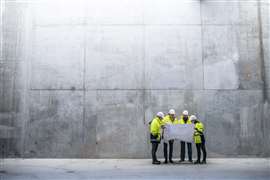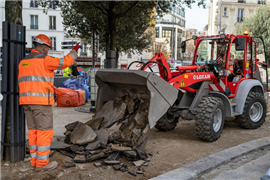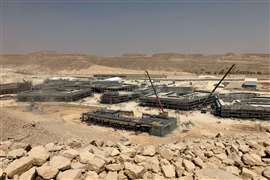Read this article in Français Deutsch Italiano Português Español
Can robots solve the US construction worker shortage?
15 April 2024
The US construction industry faces a severe worker shortage at the moment. In fact, in order to meet demand this year, the industry would need to bring in 500,000 more workers beyond its normal recruitment levels.
 A paper from Deloitte recently suggested that 2024 will see increases in construction for transportation infrastructure, manufacturing, and clean energy (Photo: AdobeStock)
A paper from Deloitte recently suggested that 2024 will see increases in construction for transportation infrastructure, manufacturing, and clean energy (Photo: AdobeStock)
In response, some construction startups have recently been raising funding to build construction robots. Could these robots be the answer to the shortage? And what are the long-term implications for the construction industry?
A paper from Deloitte recently suggested that 2024 will see increases in construction for transportation infrastructure, manufacturing, and clean energy.
But it’s likely that construction companies will struggle to compete for those projects. As far back as 2021, nearly half of contractors have had to turn down projects because they didn’t have enough workers. Since then, the problem has worsened. With just 4.6% of construction workers currently unemployed, the question becomes: Where are those half a million extra workers going to come from?
The construction industry’s answer so far has focused on developing new technologies, such as robotics and machine-assisted applications, to help fill the gaps. For example, the use of drones has become increasingly popular for tasks such as 3D mapping, site inspection, and security. Drones provide construction companies with the ability to provide real-time updates and aerial views of projects with minimal human involvement.
In addition, there are various types of autonomous construction equipment already in use, such as exoskeletons that deliver mechanical power, devices that improve health & safety, machines that perform dozing, excavating, loading, maintenance, and progress tracking. But I think it’s safe to say that bricklaying and concrete laying robots are something that most industry professionals never saw possible by machines.
The rise of construction robots
 "The second hurdle is that there are still a lot of naysayers who claim robots are going to steal construction workers’ jobs" (Photo: AdobeStock)
"The second hurdle is that there are still a lot of naysayers who claim robots are going to steal construction workers’ jobs" (Photo: AdobeStock)
More recently, companies like COBOD have challenged that assumption. Their world leader in 3D construction printing solutions significantly reduces construction costs and time. The startup’s modular and gantry-based 3D printer works at unprecedented speeds, building houses in a matter of days, not months.
Moreover, 3D construction printers offer more sustainable concrete solutions. COBOD and building material giant, Cemex, have worked together to introduce a proprietary admixtures family called D.fab that allows conventional concrete to be efficiently tailored for 3D printing, reducing material use and waste.
Unfortunately, the current perception of robotic technology among builders and contractors is mixed, with both enthusiasm for its potential benefits and resistance due to concerns over feasibility and cost. However, as adoption of this technology becomes more commonplace, upfront costs will decrease.
Bricklaying robots
On the other hand, some startups are offering brick-laying services of robots, rather than the robots themselves. These companies charge by the brick, which can be much more affordable for construction companies. So the cost of these machines may no longer be prohibitive in the near future.
The second hurdle is that there are still a lot of naysayers who claim robots are going to steal construction workers’ jobs. All I can say is that robots would first need to fill a huge number of empty positions before construction companies would need to lay off a single worker. Statistically, it’s just not an issue right now, yet there is still widespread concern about this point.
Despite the challenges, there’s a growing recognition of the inevitability and benefits of automation in construction. Robots are becoming more popular in the construction industry and bringing greater efficiency to an overwhelmed and growing industry.
If you’re a construction leader wondering if robots are the right choice, consider contracting a company that charges by the service as a pilot program to try them out on a short-term basis. While you’re at it, let your workers in on the bigger picture of the industry’s labour troubles.
Construction leaders understand the fear that comes with bringing robots to the construction site. However, I believe we’re far away from that eventuality in the construction industry, and the more pressing problem at the moment is solving the labour shortage and bringing the construction industry into the 21st century. And construction robots could just be one of the answers.
About the author

Iribar deeply explores and analyzes advanced technologies for the construction industry and helps identify investment and business development opportunities with new startups, projects, and entities of the construction technology ecosystem across multiple markets.
He also leads the efforts for the industry’s biggest challenge for construction startups, Cemex Ventures’ Construction Startup Competition.
STAY CONNECTED



Receive the information you need when you need it through our world-leading magazines, newsletters and daily briefings.
CONNECT WITH THE TEAM











